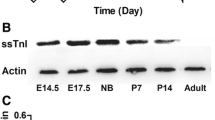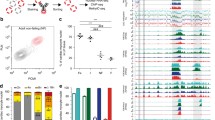Abstract
Cardiac gene expression regulation is controlled not only by genetic factors but also by environmental, i.e., epigenetic factors. Several environmental toxic effects such as oxidative stress and ischemia can result in abnormal myofibril gene expression during heart development. Troponin, one of the regulatory myofibril proteins in the heart, is a well-known model in study of cardiac gene regulation during the development. In our previous studies, we have demonstrated that fetal form troponin I (ssTnI) expression in the heart is partially regulated by hormones, such as thyroid hormone. In the present study, we have explored the epigenetic role of histone modification in the regulation of ssTnI expression. Mouse hearts were collected at different time of heart development, i.e., embryonic day 15.5, postnatal day 1, day 7, day 14 and day 21. Levels of histone H3 acetylation (acH3) and histone H3 lysine 9 trimethylation (H3K9me3) were detected using chromatin immunoprecipitation assays in slow upstream regulatory element (SURE) domain (TnI slow upstream regulatory element), 300-bp proximal upstream domain and the first intron of ssTnI gene, which are recognized as critical regions for ssTnI regulation. We found that the levels of acH3 on the SURE region were gradually decreased, corresponding to a similar decrease of ssTnI expression in the heart, whereas the levels of H3K9me3 in the first intron of ssTnI gene were gradually increased. Our results indicate that both histone acetylation and methylation are involved in the epigenetic regulation of ssTnI expression in the heart during the development, which are the targets for environmental factors.




Similar content being viewed by others
References
Tobacman, L. S. (1996). Thin filament-mediated regulation of cardiac contraction. Annual Review of Physiology, 58, 447–481.
Ausoni, S., et al. (1991). Developmental expression of rat cardiac troponin I mRNA. Development, 112, 1041–1051.
Zhu, L., et al. (1995). Developmental regulation of troponin I isoform genes in striated muscles of transgenic mice. Development Biology, 169, 487–503.
Gao, W. D., et al. (1997). Role of troponin I proteolysis in the pathogenesis of stunned myocardium. Circulation Research, 80, 393–399.
Hunkeler, N. M., Kullman, J., & Murphy, A. M. (1991). Troponin I isoform expression in human heart. Circulation Research, 69, 1409–1414.
Liu, J., et al. (2007). Progressive troponin I loss impairs cardiac relaxation and causes heart failure in mice. American Journal of Physiology Heart and Circulatory Physiology, 293, 1273–1281.
Huang, X., et al. (1999). Cardiac troponin I gene knockout: a mouse model of myocardial troponin I deficiency. Circulation Research, 84, 1–8.
Huang, X., et al. (2000). Thyroid hormone regulates slow skeletal troponin I gene inactivation in cardiac troponin I null mouse hearts. Journal of Molecular and Cellular Cardiology, 32, 2221–2228.
Du, J., et al. (2008). Functional characterization of mouse fetal TnI gene promoters in myocardial cells. Journal of Biomedical Science, 15, 605–613.
Nan, C., & Huang, X. (2009). Transcription factor Yin Yang 1 represses fetal troponin I gene expression in neonatal myocardial cells. Biochemical and biophysical research communications, 378, 62–67.
Nakayama, M., Cheng, J., Stauffer, J., Banerjee-Basu, S., Wawrousek, E., & Buonanno, A. (1996). Common core sequences are found in skeletal muscle slow-, fast-fiber-type-specific regulatory elements. Molecular and Cellular Biology, 16, 2408–2417.
Calvo, S., et al. (1999). Fiber-type-specific transcription of the troponin I slow gene is regulated by multiple elements. Molecular and Cellular Biology, 19, 515–525.
Sun, H., et al. (2010). Inhibition of p300-HAT results in a reduced histone acetylation and down-regulation of gene expression in cardiac myocytes. Life Sciences, 87, 707–714.
Rice, J. C., & Allis, C. D. (2001). Histone methylation versus histone acetylation: new insights into epigenetic regulation. Current Opinion in Cell Biology, 13, 263–273.
Vakoc, C. R., Mandat, S. A., Olenchock, B. A., & Blobel, G. A. (2005). Histone H3 lysine 9 methylation and HP1 gamma are associated with transcription elongation through mammalian chromatin. Molecular and Cellular Biology, 19, 381–391.
Liang, G., et al. (2004). Distinct localization of histone H3 acetylation and H3-K4 methylation to the transcription start sites in the human genome. Proceedings of the National Academy of Sciences of the United States of America, 101, 7357–7362.
Chapelle, J. P. (2005). Cardiac Troponin I and Troponin T: Recent Players in the Field of Myocardial Markers. Clinical Chemistry and Laboratory Medicine, 37, 11–20.
Wu, A. H., & Christenson, R. H. (2013). Analytical and assay issues for use of cardiac troponin testing for risk stratification in primary care. Clinical Biochemistry, 46, 969–978.
Sasse, S., Brand, N. J., Kyprianou, P., Dhoot, G. K., Wade, R., Arai, M., et al. (1993). Troponin I gene expression during human cardiac development and in end-stage heart failure. Circulation Research, 72, 932–938.
Boheler, K. R., & Schwartz, K. (1992). Gene expression in cardiac hypertrophy. Trends in Cardiovascular Medicine, 2, 176–182.
Cumming, D. V., et al. (1995). Troponin I and T protein expression in experimental cardiac hypertrophy. Cardioscience, 6, 65–70.
Zhu, L., Lyons, G. E., Juhasz, O., Joya, J. E., Hardman, E. C., & Wade, R. (1995). Developmental regulation of troponin I isoform genes in striated muscles of transgenic mice. Developmental Biology, 169, 487–503.
Banerjee-Basu, S., & Buonanno, A. (1993). cis-acting sequences of the rat troponin I slow gene confer tissue- and development-specific transcription in cultured muscle cells as well as fiber type specificity in transgenic mice. Molecular and Cellular Biology, 13, 7019–7028.
Barton, Paul J. R., Mullen, Antony J., Cullen, Martin E., et al. (2000). Genes encoding troponin I and troponin T are organized as three paralogous pairs in the mouse genome. Mammalian Genome, 11, 926–929.
Cullen, Martin E., Dellow, Kimberley A., & Barton, Paul J. R. (2004). Structure and regulation of human troponin genes. Molecular and Cellular Biochemistry, 263, 81–90.
Acknowledgments
This study was supported in part by research grants from Natural Science Foundation of China (NSFC Grant Number: 31271218 to Xupei Huang).
Author information
Authors and Affiliations
Corresponding author
Additional information
Weian Zhao and Lingjuan Liu have contributed equally to this work.
Rights and permissions
About this article
Cite this article
Zhao, W., Liu, L., Pan, B. et al. Epigenetic Regulation of Cardiac Myofibril Gene Expression During Heart Development. Cardiovasc Toxicol 15, 203–209 (2015). https://doi.org/10.1007/s12012-014-9278-7
Published:
Issue Date:
DOI: https://doi.org/10.1007/s12012-014-9278-7




